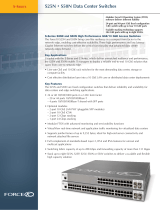Page is loading ...

2 Dell Force10 S25N or 50N Switch Configuration
Revisions
Date
Description
April 2012
Initial release
June 2012
Minor edits
April 2013
Minor edits
© 2013 Dell Inc. All Rights Reserved. Dell, the Dell logo, and other Dell names and marks are trademarks of Dell Inc. in
the US and worldwide. All other trademarks mentioned herein are the property of their respective owners.

3 Dell Force10 S25N or 50N Switch Configuration
1 Establish console access
To perform this configuration you will need the following:
• A DB9 to RJ45 serial cable (an adapter is provided with the Force10 switch).
• A management station (server, desktop, or laptop) running Windows (XP, 7, 2003, 2008) in close
proximity to the switch (i.e. the serial cable must connect from this system to the switch). You may
also use a Windows host server for this.
• A terminal emulator such as HyperTerminal, Putty, or TeraTerm. HyperTerminal is only available in
Windows XP and 2003. Putty and TeraTerm can be found for download through a quick internet
search.
2 Hardware setup
1. Stack two Dell Force10 switches using the appropriate stacking cables and turn the power on.
2. Connect a serial cable to the serial port of the switch that shows A0 or B0 on the LED display.
Note: Make sure that the serial connection is made to the No. 1 (or management) unit in order to access
the console.
3. Using Putty or another terminal utility, open a serial connection session to the switch.
4. Open your terminal emulator and configure it to use the serial port (usually COM1 but this may
vary depending on your system). Configure serial communications for 9600,N,8,1 and no flow
control.
5. For out-of-band network management, connect port 48 from the first switch to the LAN (client or
management) network.

4 Dell Force10 S25N or 50N Switch Configuration
3 Switch configuration
Note: Ensure that the switch is running version 8.4.2.4 or later. If the switch is running an earlier version,
please visit http://www.force10networks.com and download the latest update or call Dell support for
assistance.
1. Clear the current configuration:
Force10>
Force10>enable
Force10#delete startup-config
Force10#reload
Note: The switches will reboot.
2. Configure port 24 (on the S25N) or port 48 (on the S50N) switch for out-of-band management:
Force10>
Force10>enable
Force10#config
Force10#interface GigabitEthernet 0/port
Force10(conf-if-gi-0/<port>)#ip address ipaddress mask
Example: ip address 192.168.40.204 /24
Note: Use the out-of-band switch management IP address noted in the prerequisites table.
Force10(conf-if-gi-0/<port>)#no shut
Force10(conf-if-gi-0/<port>)#exit
3. Configure a route for the out-of-band management port:
Note: X.Y.Z.0 is the network your management system is connecting from, A.B.C.1 is the gateway for the
switch. If your management system is on the same subnet as the switch, omit the next step.
Force10(conf)#ip route X.Y.Z.0 /24 A.B.C.1
4. Configure login credentials for Telnet access.
Force10(conf)#username admin pass yourpassword
Force10(conf)#enable password level 15 0 yourpassword

5 Dell Force10 S25N or 50N Switch Configuration
5. Configure the remaining ports:
Note:
##
denotes 23 for the S25N or 47 for the S50N.
Force10(conf)#int range gig 0/1 - ## , gig 1/1 - ##
Force10(conf-if-range-gi-0/1-##)#mtu 9216
Force10(conf-if-range-gi-0/1-##)#no shut
force10(conf-if-range-gi-0/1-##)#switchport
Force10(conf-if-range-gi-0/1-##)#spanning-tree rstp edge-port
Force10(conf-if-range-gi-0/1-##)#flowcontrol rx on tx on
Force10(conf-if-range-gi-0/1-##)#exit
Force10(conf)#buffer-profile global 1Q
Force10(conf)#exit
6. Save the settings:
Force10#copy run start
7. Reload the switch. (For the buffer profile to take effect, reload the system).
Force10#reload
Note: The preceding procedure places all switch ports in the default VLAN. If you prefer to place ports in
a non-default VLAN, refer to the documentation for your switch.
/

